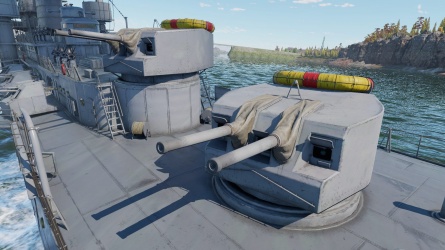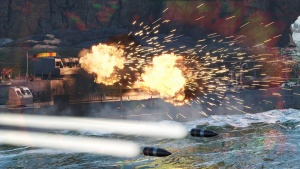135 mm/45 O.T.O. Mod. 1937 (135 mm)

Contents
Description
135 mm/45 O.T.O. Mod. 1937 was an Italian naval gun designed as a response to the French 138.6 mm/50 and was planned to be used on a wide variety of warships - from destroyers to battleships. Most of these planes were cancelled before completion, as the gun was introduced on the verge of WW2, and didn't see any major naval engagements before the armistice.
In the game, it's best used against destroyers and coastal vessels, as it features few characteristics that make it excellent in that role. Against cruisers, it will, however, suffer significantly from having a relatively low explosive filler.
Vehicles equipped with this weapon
General info
The gun is available in 4 different mounts. A single mount used on destroyers has the most rudimentary anti-fragmentation mount. Twin cruiser mount has insufficient protection to stop anything but the machine guns. Battleship secondaries come in two distinct mounts, and while both have a nearly identical armor, the twin-mount used on Cavour is somewhat more difficult to penetrate due to having a much smaller face and a side armor at a very steep angle.
| Ship | Guns per mount |
Front | Sides | Top | Elevator | ||||
|---|---|---|---|---|---|---|---|---|---|
| Thickness (mm) |
Type | (mm) | Type | (mm) | Type | (mm) | Type | ||
| RN Conte di Cavour | 2 | 120 | RCA | 80 | RCA | 60 | RHA | 100 | RCA |
| RN Duilio | 3 | 120 | RCA | 80 | RCA | 60 | RHA | 100 | RCA |
| RN Etna RN Attilio Regolo |
2 | 20 | RHA | 6 | RHA | 6 | RHA | 0 | — |
| RN Comandante Margottini | 1 | 12 | AfA | 12 | AfA | 12 | AfA | 0 | — |
Available ammunition

The choice of shells is typical for the Italian pre-WW2 guns, limited to HE and AP against surface targets and HE-TF against aircraft. It's adequate for nearly every situation a warship can encounter.
- 135 mm HE Dirompente - Universal high-explosive round, great against frigates and torpedo boats alike, to a degree also useful against enemy destroyers, or to ignite heavier warships on fire.
- 135 mm APHEBC Perforante - The shell of choice against enemy cruisers, or to reach the ammo racks on destroyers. It lacks penetration to deal with some of the heavy cruisers or all of the battleships/battlecruisers, so against them the HE rounds would be a better choice.
- 135 mm HE-TF Contro-aerea - Time-fused high explosive shell, able to counter enemy aircraft through shrapnel. Use Distance fuse set accuracy crew skill to increase the probability of fusing in the perfect spot for the kill - however, even with the skill maxed-out, shells still can explode ± 100 m away from a target at 5000 meters range, which is more than enough for the aircraft to avoid taking any damage. Still - it's by far the best round to use against enemy airplanes.
| Penetration statistics | |||||||
|---|---|---|---|---|---|---|---|
| Ammunition | Type of warhead |
Penetration @ 0° Angle of Attack (mm) | |||||
| 1,000 m | 2,500 m | 5,000 m | 7,500 m | 10,000 m | 15,000 m | ||
| HE Dirompente | HE | 23 | 23 | 23 | 23 | 23 | 23 |
| APHEBC Perforante | APHEBC | 171 | 139 | 100 | 73 | 56 | 45 |
| HE-TF Contro-aerea | HE-TF | 23 | 23 | 23 | 23 | 23 | 23 |
| Shell details | ||||||||||||
|---|---|---|---|---|---|---|---|---|---|---|---|---|
| Ammunition | Type of warhead |
Velocity (m/s) |
Projectile mass (kg) |
Fuse delay (s) |
Fuse sensitivity (mm) |
Explosive mass (TNT equivalent) (kg) |
Ricochet | |||||
| 0% | 50% | 100% | ||||||||||
| HE Dirompente | HE | 825 | 32.42 | 0 | 0.1 | 1.8 | 79° | 80° | 81° | |||
| APHEBC Perforante | APHEBC | 825 | 32.73 | 0.01 | 6 | 1.47 | 48° | 63° | 71° | |||
| HE-TF Contro-aerea | HE-TF | 825 | 32.42 | 0 | 0.1 | 1.8 | 79° | 80° | 81° | |||
Comparison with analogues
135 mm is a fairly unusual calibre, thus the comparison will be made with the guns of relatively similar calibre used as either primary guns on cruisers, or secondary guns on battleships/battlecruisers. Pure destroyer guns are intentionally skipped.
HE
| Cannon | Sample Ship | Ammo | Calibre (mm) |
Muzzle Velocity (m/s) |
Sustained rate of fire (rounds/min) |
Targeting speed (°/s) |
TNT Equivalent (kg) |
Penetration @ 0° Angle of Attack (mm) | ||||
|---|---|---|---|---|---|---|---|---|---|---|---|---|
| Horizontal | Vertical | 1,000 m | 5,000 m | 10,000 m | ||||||||
| 135 mm/45 O.T.O. Mod. 1937 | RN Etna | HE | 135 | 825 | 7.5 | 9.5 | 9.5 | 1.8 | 23 | 23 | 23 | |
| 5 inch/38 Mk.12 (127 mm) | USS Atlanta | HE | 127 | 792 | 15 | 21 | 13 | 3.22 | 36 | 36 | 36 | |
| 150 mm/45 SK L/45 (150 mm) | SMS Elbing | HE | 150 | 835 | 7 | 4.2 | 4.2 | 1.6 | 21 | 21 | 21 | |
| 130 mm/55 pattern 1913 (130 mm) | Imperatritsa Mariya | HE | 130 | 823 | 8 | 3.4 | 3.4 | 3.9 | 37 | 37 | 37 | |
| 140 mm/50 3rd Year Type (140 mm) | IJN Sendai | HE | 140 | 840 | 6.2 | 8.0 | 8.0 | 3.15 | 35 | 35 | 35 | |
| 138.6 mm/55 model 1910 (138.6 mm) | Lorraine | HE | 139 | 840 | 6 | 4.2 | 4.2 | 4.41 | 36 | 36 | 36 | |
AP/SAP
| Cannon | Sample Ship | Ammo | Calibre (mm) |
Muzzle Velocity (m/s) |
Sustained rate of fire (rounds/min) |
Targeting speed (°/s) |
TNT Equivalent (kg) |
Penetration @ 0° Angle of Attack (mm) | ||||
|---|---|---|---|---|---|---|---|---|---|---|---|---|
| Horizontal | Vertical | 1,000 m | 5,000 m | 10,000 m | ||||||||
| 135 mm/45 O.T.O. Mod. 1937 | RN Etna | APHEBC | 135 | 825 | 7.5 | 9.5 | 9.5 | 1.47 | 171 | 100 | 56 | |
| 5 inch/38 Mk.12 (127 mm) | USS Atlanta | SP Common Mk.46 | 127 | 792 | 15 | 21 | 13 | 0.9065 | 150 | 95 | 56 | |
| 150 mm/45 SK L/45 (150 mm) | SMS Elbing | APCBC | 150 | 835 | 7 | 4.2 | 4.2 | 0.99 | 238 | 153 | 93 | |
| 130 mm/55 pattern 1913 (130 mm) | Imperatritsa Mariya | SAPBC | 130 | 823 | 8 | 3.4 | 3.4 | 1.67 | 178 | 115 | 71 | |
| 140 mm/50 3rd Year Type (140 mm) | IJN Sendai | mod 1 SAP | 140 | 855 | 6.2 | 8.0 | 8.0 | 2.21 | 115 | 81 | 54 | |
| 138.6 mm/55 model 1910 (138.6 mm) | Lorraine | SAPBC | 139 | 790 | 6 | 4.2 | 4.2 | 2.93 | 73 | 47 | 34 | |
Usage in battles
The biggest weakness of this gun largely determines its use. The low explosive filler makes it less effective to deal with cruisers than it might appear after reading the penetration table. Thus, it's particularly good at dealing with enemy destroyers and coastal vessels, while struggling to score kills on heavier warships.
Pros and cons
Pros:
- Good rate of fire
- High muzzle velocity
- Sufficient penetration to counter any light cruiser and even some of the heavy cruisers
Cons:
- Very small explosive filler of the HE and HE-TF shells
History
Originally designed in response to the French 138.6 mm/50, the 135/45 was initially planned to be introduced first with the Capitani Romani class in order to counter French large destroyers (contre-torpilleur), but after the outstanding performance of the guns they got recommended for the 1937 refits of the Duilio-class. They proved to have a lower dispersion than even the latest of the 120 mm guns, while having a higher maximum range and larger explosive filler.
During the war, a new single-mounts were developed for the Comandanti M. d'Oro-class. Only one hull of the class - RN Comandante Margottini - was launched, unarmed, to make space in the shipyard. The guns were instead planned to be used on the Yugoslav destroyer Dubrovnik, but the plan didn't come to fruition before the armistice in September 1943. Similar fate met the guns planned for aircraft carrier Aquila and cruisers Etna and Vesuvio. Finally, before the armistice, the refit of the Conte di Cavour was already in progress, with some of the 120 mm guns being already replaced by the twin 135 mm turrets.
The single-mount guns were also used for coastal defence since early 1943, primarily on the north coast of Sardinia.
During the Cold War, a new, fully automated anti-air mount was designed for the refit of the Giuseppe Garibaldi, but never seen any other use outside the one-off cruiser.
Media
Excellent additions to the article would be video guides, screenshots from the game, and photos.
See also
Links to the articles on the War Thunder Wiki that you think will be useful for the reader, for example:
- reference to the article about the variant of the cannon/machine gun;
- references to approximate analogues by other nations and research trees.
External links
- [Wikipedia] 135 mm/45 Italian naval gun
- [NavWeaps] 135 mm/45 (5.3") Models 1937 and 1938
- The Weapons of the Italian Ships (Le armi delle Navi Italiane) by Erminio Bagnasco, page 35 - 37
- From Glasgow to Genoa under three flags – the Yugoslav flotilla leader Dubrovnik by Zvonimir Freivogel, page 87



